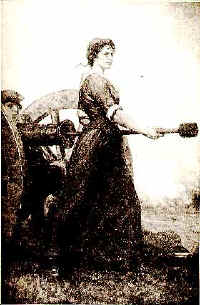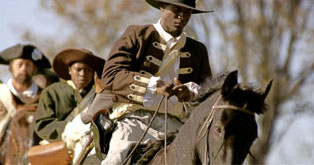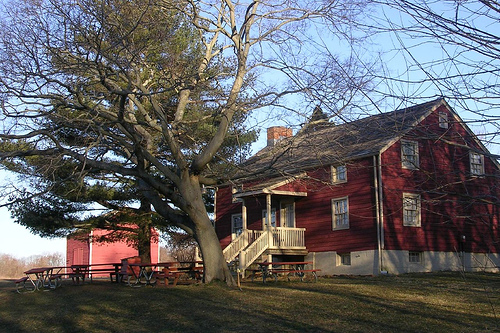
Famous People in Monmouth County
Joseph Murray and his wife Rebecca purchased part of the Throckmorton land in 1767. Joseph Murray was a Scots-Irish immigrant from Londonderry. They had four children and Joseph Murray soon joined the local Militia during the Revolutionary War. Joseph did work around his home and farm and, built his own home and barn, like many other people in the 1700's. He made his living off of selling his yearly crops. Joseph Murray was murdered by a loyalist while working in the corn field behind the barn.
The man responsible for Joseph Murray’s death is Colonel Tye. He was a slave for John Corlies of Shrewsbury. Like many of the black people, Tye ran away from his old life leaving everything behind and even changing his name. Known as Titus he was one of four men enslaved by Corlies, in the eastern part of Monmouth County. John Corlies was a Quaker who was under pressure from their Philadelphia-influenced counterparts of the west, that began to end slavery among themselves. John Corlies did not follow the practice of educating his slaves and release them after their 21st birthdays. By late 1775 he was one of the few remaining slave holders in Monmouth County. Tye left in 1775 and joined a flood of Monmouth County blacks who sought to find refuge with British soldiers. His first known battle was the Battle of Monmouth. He was made famous by capturing a captain in the Monmouth militia. In July 1779 Tye launched a raid on Shrewsbury carrying away clothing, furniture, horse, cattle, and two town's people. Using his knowledge about Monmouth County he disappeared into the rivers quickly.
To look at Joseph Murray's home and learn about it, you can see it in Poricy Park. Just call ahead to make an appointment with the rangers. There are so many things to see and learn about in that house. We would definitely suggest visiting this home!
The man responsible for Joseph Murray’s death is Colonel Tye. He was a slave for John Corlies of Shrewsbury. Like many of the black people, Tye ran away from his old life leaving everything behind and even changing his name. Known as Titus he was one of four men enslaved by Corlies, in the eastern part of Monmouth County. John Corlies was a Quaker who was under pressure from their Philadelphia-influenced counterparts of the west, that began to end slavery among themselves. John Corlies did not follow the practice of educating his slaves and release them after their 21st birthdays. By late 1775 he was one of the few remaining slave holders in Monmouth County. Tye left in 1775 and joined a flood of Monmouth County blacks who sought to find refuge with British soldiers. His first known battle was the Battle of Monmouth. He was made famous by capturing a captain in the Monmouth militia. In July 1779 Tye launched a raid on Shrewsbury carrying away clothing, furniture, horse, cattle, and two town's people. Using his knowledge about Monmouth County he disappeared into the rivers quickly.
To look at Joseph Murray's home and learn about it, you can see it in Poricy Park. Just call ahead to make an appointment with the rangers. There are so many things to see and learn about in that house. We would definitely suggest visiting this home!
Each spot we went to we learned something new. About how all events were important to the Revolutionary War. We learn about the hard ships in war, the cruelty, and the conflicts that divide a nation. Many people were confuson about which side to support and help. What would you choice?
Molly Pitcher as she was called on the battle field, her real name was Mary Ludwig Hays McCauley. Molly like many other families follow the men of the family to war. At the Battle of Monmouth in June 1778, Mary Hays, Molly Pitcher ran, water to the fallen soldiers. The hot sun beat down on the men as they fought dropping like flies. Instead of calling "Mary, water please." the soliders hollered out "Molly Pitcher!" Just before the battle started, she found a spring to serve as her water supply. Molly spent much of early day carrying water to soldiers and artillerymen, often under heavy fire from British troops. The weather was hot, over 100 degrees Fahrenheit. As she ran water to the soldiers, during that time her husband was wounded dropping from the cannon. She grabbed the rammer use to load and fire. As her husband was carried off the battlefield, Mary Hays took his place at the cannon. For the rest of the day, in the heat of battle, Mary continued to "swab and load" the cannon using her husband's rammer. At one point, a British musket ball or cannon ball flew between her legs and tore off the bottom of her skirt. Mary supposedly said, "Well, that could have been worse," and went back to loading the cannon. Later in the evening, the fighting was stopped due to gathering darkness. Although George Washington and his commanders expected the battle to continue the following day, they woke to no British Troops. The British forces retreated during the night and continued on to Sandy Hook. The battle was seen as a major victory for the Continental Army. After the battle, General Washington asked about the woman who he had seen loading a cannon on the battlefield. In commemoration for her courage, Washington issued Mary Hays a warrant as a non commissioned officer. Afterwards, she was known as "Sergeant Molly," a nickname that she used for the rest of her life.
Here is Molly Pitcher loading the cannon after her hunsband fell from his spot of loading the cannon.
On the left is Colonel Tye riding his horse, on the right is the Joesph Murray's house


